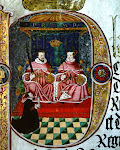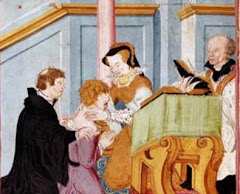A few months back I consulted several documents regarding Henry’s death in the National Archives, amongst them his will (TNA E/23/4/1). Mary’s position within the succession was approved in the third Act of Succession (1544) – ‘the saide Imperall Crowne and all other the p’misses shallbe to the Ladye Marie the Kinges Highness Daughter’[1]. The Act also allowed Henry to name additional successors in his will or by letters patent, which he duly did. In the will, the throne was left to the heirs of Frances Grey if is his youngest daughter, Elizabeth, died childless. Frances’s children, Jane, Katherine and Mary Grey, were the granddaughters of Henry VIII’s younger sister, the other Mary Tudor. So Henry bypassed the heirs of his elder sister, Margaret, Queen of Scotland which included, by 1547, the young Mary, Queen of Scots and Margaret Stewart, Countess of Lennox (who was good friends with our Mary Tudor, so much so that it was rumoured, during Mary’s reign, that she would make Margaret her heir and deny Elizabeth the throne).
Here is page eight of the will. After leaving the throne to Edward, Mary is named as the next in line:

Notice the tiny error made – the clerk put down first that the crown was to be left to ‘our sayd doughter Mary lawfully begotten’, then quickly adding in before ‘lawfully’ – ‘and the heyres of her body’. Mary’s children had to be legitimate in order to succeed her. She, on the other hand, could inherit as the King’s illegitimate daughter. It then goes on to state that any marriage she entered into must have the approval of the Privy Council. Failing to secure their consent, she risked being denied the throne.
Now only was Mary an heiress, she was also a wealthy one:

‘Further our will is that from the furst hower of our death until such tyme as the sayd Counsaillours canne provide either of them [Mary and Elizabeth] or bothe of sum honorable mariages they shall have eche of them thre thousand poundes ultra reprisas to lyve on...’
Both also inherited properties and precious goods; Mary received over thirty properties in the south-east. She continued to acquire estates, the most significant being Framlingham Castle, Suffolk, granted to her by the Crown in mid 1553. Framlingham played an important role during her campaign for the throne in the same year.
We do not know for sure whether Mary attended her father’s funeral. Katherine Parr certainly did, witnessing the burial from the Queen’s Closet that had once been constructed for Henry’s first wife, and Mary’s mother, Katherine of Aragon. There are records though for materials, namely yards of black velvet, needed for Mary and her household who were now in mourning. The National Archives holds the Lord Chamberlain’s account of ‘The precedente of the Buriall of oure late Soveragane lorde kynge henry the eighte’ (LC 2/2). It lists the ladies, gentlewomen, gentlemen, ushers, and other household staff attending Mary, providing all with suitable mourning clothes. Many of the individuals mentioned served Mary for many years, including Susan Clarencius, Mary Finch and Beatrice ap Rhys the laundress (who had been in Mary’s household by the early 1520s).


(Ladies and gentlewomen attending Mary)
For further information on Henry's will, see J. L McIntosh, From Heads of Households to Heads of State: The Preaccession Households of Mary and Elizabeth Tudor, 1516-1558 (New York: Columbia University Press, 2009), pp. 201-17, which can be read online: http://www.gutenberg-e.org/mcintosh/appendix-a.html
[1] The Statutes of the Realm, vol. III (London, 1817), p. 955.



